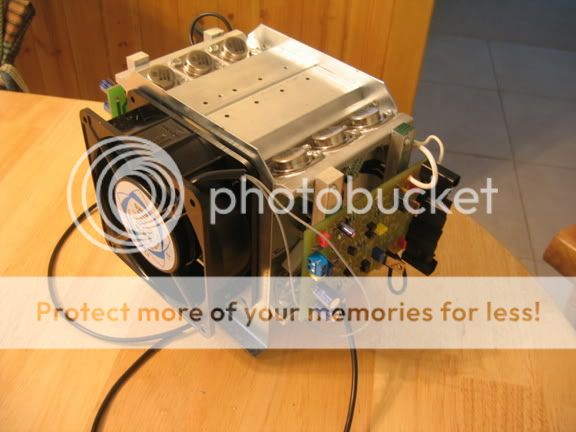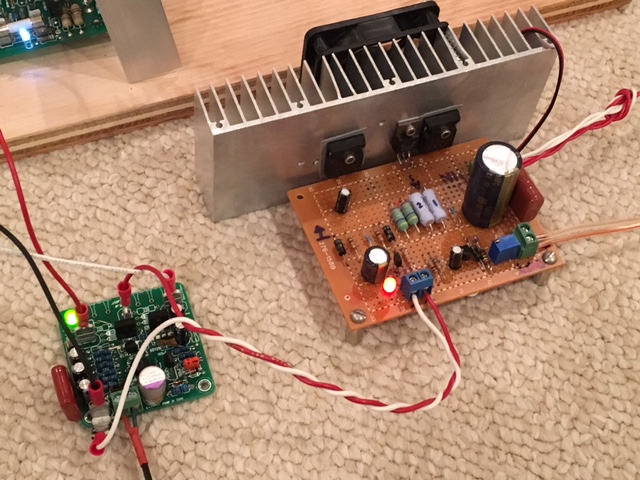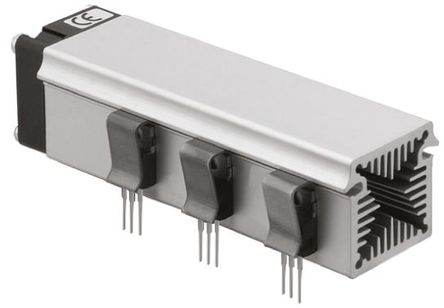I am designing an amplifier that I think I will build with 6 channels but could potentially have 8 channels. I want to use a large slowly turning fan to cool the heatsinks as well to have more power dissipation and was wondering if I'd be able to use this case with something like this fan somehow.
Dissipante 5U – diyAudio Store (BETA)
http://www.amazon.com/Be-Quiet-1500RPM-50-5CFM-16-5DBA/dp/B00AKO16BS
As its also not rated on here I was wondering what kind of power dissipation that case would give me without fans and also if there's an intuitive way to see how fans and the CFL would translate to power dissipation on the heatsinks. Also my goal with the fan is to have a large enough fan spinning slow enough to effectively cool the amp while still having it be inaudible in a dead silent room and that fan is rated down to 15 dBa which is pretty inaudible at least to my knowledge.
Dissipante 5U – diyAudio Store (BETA)
http://www.amazon.com/Be-Quiet-1500RPM-50-5CFM-16-5DBA/dp/B00AKO16BS
As its also not rated on here I was wondering what kind of power dissipation that case would give me without fans and also if there's an intuitive way to see how fans and the CFL would translate to power dissipation on the heatsinks. Also my goal with the fan is to have a large enough fan spinning slow enough to effectively cool the amp while still having it be inaudible in a dead silent room and that fan is rated down to 15 dBa which is pretty inaudible at least to my knowledge.
Cooling the external heatsinks of a case like that with any sort of fan is impractical - you may as well get a desk fan and point it at the amp. To use fan cooling effectively, fit tunnel heatsink extrusions mounted inside the case and exhausting out. There are many types and lengths as you see fitted in big pro. sound amplifiers but plenty of class A amplifiers could use them too. e.g. this great DIY Krell build here by member still4given:


Just some calculation:
If the air reach 5m/s over the heatsink, it will reduce the thermal resistance with maximum 80%. So the 1K/W heatsink became 0.2K/W. More speed will not decrease the thermal resistance.
You can calculate the speed with the CFM, and the cross sectional area You push over the air.
Saji
If the air reach 5m/s over the heatsink, it will reduce the thermal resistance with maximum 80%. So the 1K/W heatsink became 0.2K/W. More speed will not decrease the thermal resistance.
You can calculate the speed with the CFM, and the cross sectional area You push over the air.
Saji
Cooling the external heatsinks of a case like that with any sort of fan is impractical - you may as well get a desk fan and point it at the amp. To use fan cooling effectively, fit tunnel heatsink extrusions mounted inside the case and exhausting out. There are many types and lengths as you see fitted in big pro. sound amplifiers but plenty of class A amplifiers could use them too. e.g. this great DIY Krell build here by member still4given:

OK that makes sense. So if I wanted to use a tunnel heatsink, what could i use as a case and a heatsink? I guess I'm just confused as to the whole process of taking an amplifier pcb, getting a case for it and heatsink to match. I just can't seem to find where I would even buy an amplifier case or heatsinks besides the link I posted from the diyaudiostore. And also do you know how much would that case dissipate on its own? I'm still trying to figure out if fans would be necessary to my design, but from what I've seen I don't think without fans or extreme heat sinks I would get the dissipation I want from as many channels as I want.
Just some calculation:
If the air reach 5m/s over the heatsink, it will reduce the thermal resistance with maximum 80%. So the 1K/W heatsink became 0.2K/W. More speed will not decrease the thermal resistance.
You can calculate the speed with the CFM, and the cross sectional area You push over the air.
Saji
I understand the speed calculation but how does that translate to thermal resistance? And is there a way to calculate heatsink thermal resistance? For example with that case it gave the heatsink size but no thermal resistance rating or anything like that
So maybe something like this is more appropriate?
This case:
Pesante 5U – diyAudio Store (BETA)
With a couple of these tunnel heatsinks:
http://www.altronics.com.au/p/h0515-heavy-duty-tunnel-heatsink/
With the 80mm version of the fan? This is just an idea to see if I'm on the right track. Thank you for your guys's help!
This case:
Pesante 5U – diyAudio Store (BETA)
With a couple of these tunnel heatsinks:
http://www.altronics.com.au/p/h0515-heavy-duty-tunnel-heatsink/
With the 80mm version of the fan? This is just an idea to see if I'm on the right track. Thank you for your guys's help!
I understand the speed calculation but how does that translate to thermal resistance? And is there a way to calculate heatsink thermal resistance? For example with that case it gave the heatsink size but no thermal resistance rating or anything like that
The thermal resistance should be in the datasheet of the heatsink.
Sajti
IF you elect to use a fan driven Tunnel heatsink arrangement.
Then you could house the resultant contraption inside of even a Nicely made Wooden Box.
Look in the DIY Amp gallery for inspiration ?
Then you could house the resultant contraption inside of even a Nicely made Wooden Box.
Look in the DIY Amp gallery for inspiration ?
My own practical observation is that a small fan makes a HUGE difference. I had a 5w ACA class A amp using a 50mm x 100mm finned aluminum heatsink from my class AB amp and it was toasty (>60 deg C). With a $1 50mm fan from a CPU cooler, the heatsink is now barely warm. So I do think that mounting an external fan on a regular natural convection heatsink helps tremendously. I can probably cool 4 ACA's on the same heatsink reasonably well. This is consistent with the typical difference between forced air convection and natural convection heat exchangers. The heat transfer is proportional to the temperature gradient produced by the boundary layer. A thin boundary layer has high gradients (high heat transfer) and a thick boundary layer from natural convection has low heat transfer flux.
Here is how I mounted my fan: aimed flow into fins and out top and bottom. A sinple 7812 regulator off the main DC supply provides the 100mA and 12v needed to power the rather quiet fan. I use drywall screws and contact sidewall pressure from fins to hold fan in place.

Heatsink is now maybe 3-5 deg C above ambient with about 30 watts dissipation.
Here is how I mounted my fan: aimed flow into fins and out top and bottom. A sinple 7812 regulator off the main DC supply provides the 100mA and 12v needed to power the rather quiet fan. I use drywall screws and contact sidewall pressure from fins to hold fan in place.

Heatsink is now maybe 3-5 deg C above ambient with about 30 watts dissipation.
The Dissipante case looks like the image below left. The heatsink fins are relatively shallow but I would guess that each sideplate had a rating of about 0.2K/W. It would be unwise to slap a bunch of fans on the exterior of the case but you can do what you like to fit any type of fan cooling inside the case. The cost and space required are the limiting factors but it should be noted that fans exhausting into the case then dissipating out of an array of holes will guarantee a really dusty amp. That's why tunnel or ducted heatsinks, even if not perfectly sealed, can be more sensible long-term. See the tiny duct version from Fischer Elektronik also below. They do make larger products though.




An externally hosted image should be here but it was not working when we last tested it.
How about using a couple of these (or whichever one is suitable, they have lots of models) as sides, adding a top / bottom / front / back panel custom made by Front Panel Express and there's your case? All you would need to do is tap some threaded holes on the heatsinks to attach the panels, but if you don't have the tools to do it yourself, you can send them to FPE and they will do it for you. I've had a front panel made by them (the EU branch) and the quality is outstanding. It will also save you a lot of hassle drilling holes and aligning pots / connectors / etc.
Cheers,
Cabirio
Cheers,
Cabirio
The cheapest solution is a used case with heat sinks fan, speed control circuit etc from a dead or not ideal amp on craigslist. There was a PV500 in town for $100 last week.
There are new cases with heatsinks down both outsides for $280. However having them horizontal across the back behind a fan grill strikes me as better. The PV amps have louvers in the front to let the heat out. Also a top & bottom to keep air in and RF interferance out.
Another solution is a dead motor drive case. These go in the trash of factories, the heat sinks are sometimes sold to metal scrappers. Better for you with the plastic and fan circuits, although these fans tend to be 479 vac.
There are new cases with heatsinks down both outsides for $280. However having them horizontal across the back behind a fan grill strikes me as better. The PV amps have louvers in the front to let the heat out. Also a top & bottom to keep air in and RF interferance out.
Another solution is a dead motor drive case. These go in the trash of factories, the heat sinks are sometimes sold to metal scrappers. Better for you with the plastic and fan circuits, although these fans tend to be 479 vac.
Last edited:
- Status
- Not open for further replies.
- Home
- Amplifiers
- Solid State
- Case choice to work with fan?